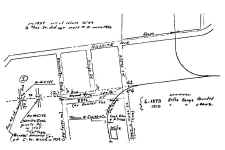by vince
Hello all,
New member here and I have some questions re; 1950's LIRR era.
What was the maximum ever allowed track speed on the Jamaica Bay Trestle.
-and-
I'm modelling this box, a clip here from a photo in the Dave Keller collection, taken on the Creedmoor Branch near the Jericho Sash & Door siding.
I want to get the colors right and have painted it red/white stripes as a start.
I have preliminaraly chosen red because it seems to be close up and personal to the third rail. A power cut off? A fuse.
But I remember the manual crossing gates were Black/White stripes and I cant tell from the picture.
Thanks in advance
Vince
New member here and I have some questions re; 1950's LIRR era.
What was the maximum ever allowed track speed on the Jamaica Bay Trestle.
-and-
I'm modelling this box, a clip here from a photo in the Dave Keller collection, taken on the Creedmoor Branch near the Jericho Sash & Door siding.
I want to get the colors right and have painted it red/white stripes as a start.
I have preliminaraly chosen red because it seems to be close up and personal to the third rail. A power cut off? A fuse.
But I remember the manual crossing gates were Black/White stripes and I cant tell from the picture.
Thanks in advance
Vince
